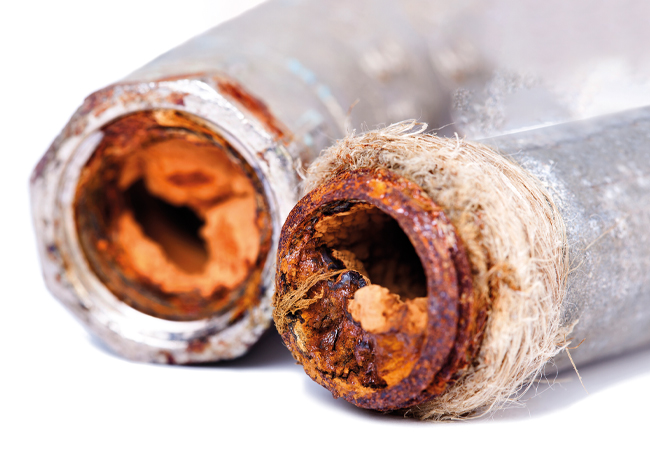
Water quality management within new and existing UK district heating schemes is a costly process that is often not carried out to industry guidance standards. These include BSRIA BG 29 Pre-commission cleaning of pipework systems; BS 8552:2012 Sampling and monitoring of water from building services closed systems and BSRIA BG 50 Water treatment for closed heating and cooling systems.
It has been found that 15% of heat networks within the UK require unbudgeted remedial works within the first two years, and the majority of these are probably because of a lack of understanding of the importance of maintaining water quality 1. If suitable procedures are introduced via additional technology, it can only improve the cost and operating efficiencies of heat networks and play a large part in decarbonising heat in the UK.
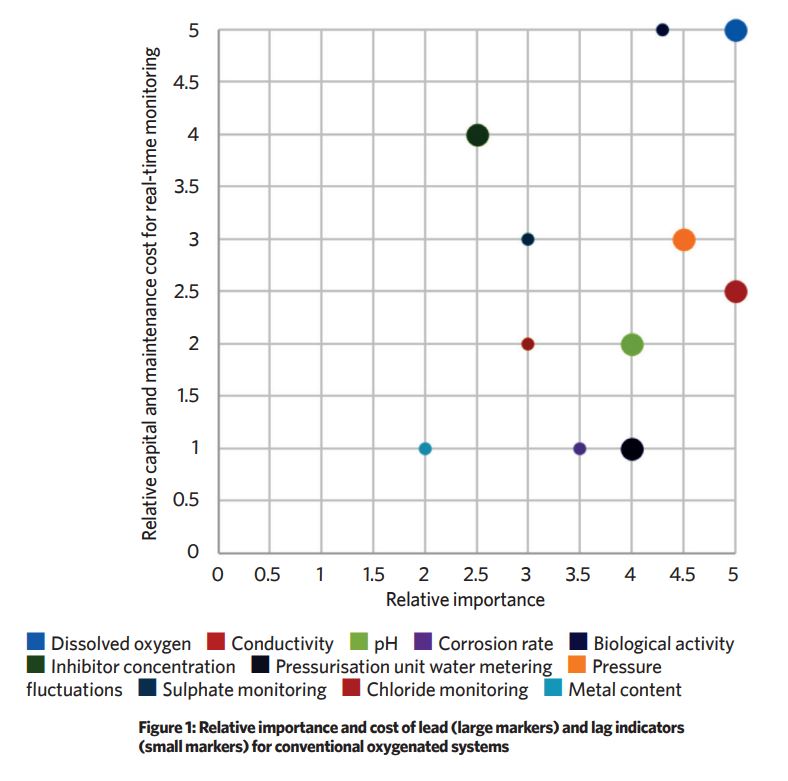
Other qualitative benefits include: removal of sampling ambiguity at the pre-commissioning phase; instantaneous identification of changes to water quality via alarms; improved visibility on system water chemistry throughout a project lifetime; and increased accountability and improvement of contractual lines and accountability.
The qualitative benefits highlighted above, however, can only be realised if the installation and operation of online monitoring equipment shows cost improvements when compared with conventional sampling and monitoring methods.
The study 1 investigates the key parameters that are most influential in determining water quality and the ability for the system water to deteriorate system components. These have been categorised as a lead indicator (identifying when a system moves towards corrosive conditions) or lag indicator (identifying when corrosion has already occurred) across oxygenated and de-oxygenated systems, to enable targeted selection of parameters for online water-quality monitoring.
The financial assessment of two online monitoring arrangements have been conducted across three different-sized residential heat networks over a 20-year period (Table 1). Each online monitoring regime has subsequently been compared against the recommended sampling approach stated in BSRIA BG 29 and BSRIA BG 50.
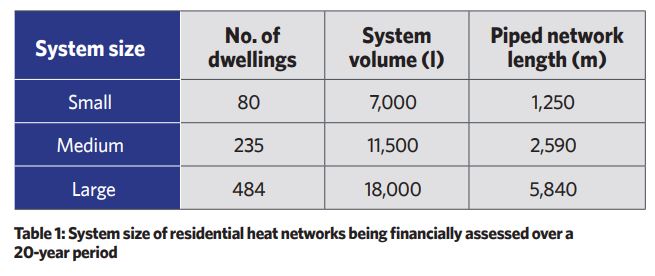
It is well documented that three key parameters can identify if conditions are favourable for corrosion to occur: pH, electrical conductivity, and oxygen content2. Additionally, system pressure control and fill-water monitoring are identified within literature as of high importance to ensure the system is adequately protected from oxygen ingress and inhibitor depletion (where applicable).
Introducing high volumes of fill water into the system can also indicate if leaks are occurring, providing insight as to whether the system is watertight. To maintain control over water quality, the amount of fill water entering a system should be measured and routinely checked, regardless of the methodology – de-oxygenated or chemically dosed – used to maintain water quality.
Categorising all water-quality parameters into lead and lag indicators adds weighting to the parameters that identify when system water trends towards corrosive conditions before corrosion occurs. Therefore, monitoring lead water quality parameters continuously increases the effectiveness of the online monitoring equipment, enabling proactive maintenance works to take place before (significant levels of) corrosion takes place.
Because of the increasing uptake of de-oxygenated systems within the UK, this study was conducted over conventional dosed and de-oxygenated systems.
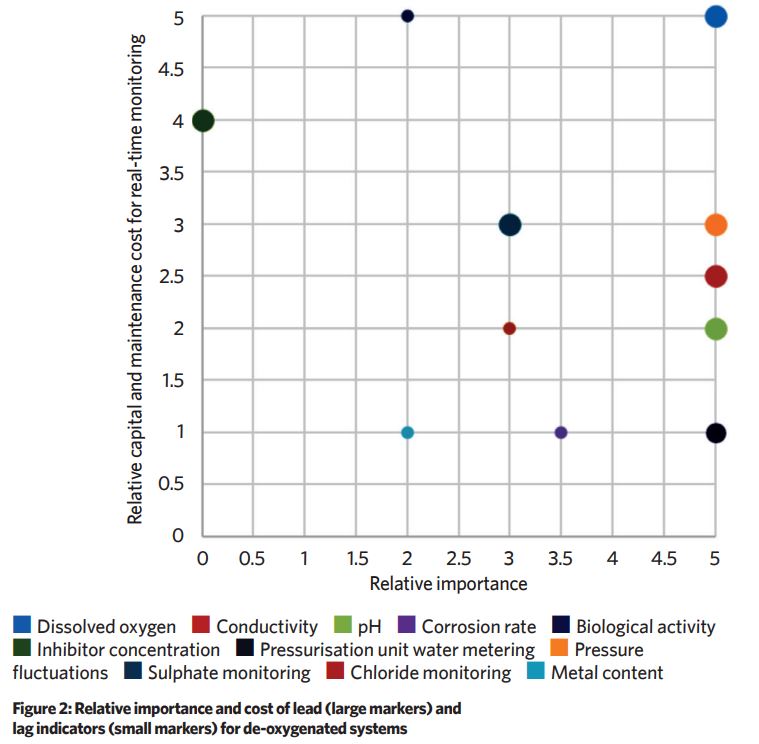
De-oxygenated systems provide a more clear-cut set of monitoring parameters because of the lack of complexity within the water chemistry. De-oxygenating a district heating system would shift the relevant guidance documents from BSRIA BG 29 and BSRIA BG 50 to the German water standard VDI 2035.
Monitoring options
Regardless of the system type, the monitoring parameters with the highest relative importance are consistent and in line with literature findings.
The following combinations of monitoring options have been selected for life-cycle analysis based on the key parameters highlighted above across both systems.
Option 1 monitors all the parameters with a relative importance deemed greater than a value of 3, shown in Table 1 within a single monitoring unit.
Option 2 provides analysis on a hybrid monitoring regime with standalone probes for all key monitoring parameters with a relative importance greater than 4.
The results from the financial assessment show there is good economic feasibility for online real-time water quality monitoring. The increased capital investment upfront is quickly recovered by the reduced requirement for sampling to BSRIA BG 29 standards during the commissioning phase before system handover.
From an install and commissioning perspective, installation of online monitoring would be economically viable in cases where larger system sizes and longer commissioning phase durations are present, as the cost variation from sampling is improved.
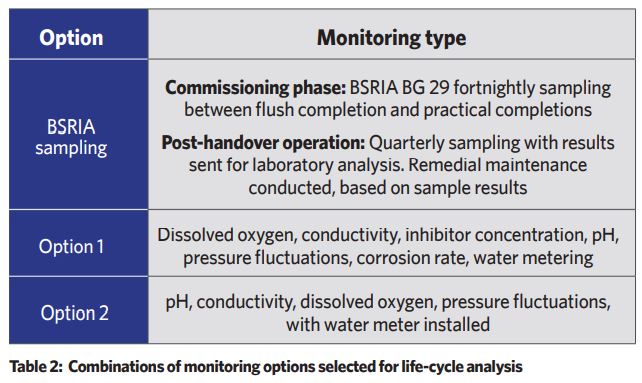
The overall net present value observed at system handover and year 20 are significantly impacted by an increase in commissioning phase duration of a project, regardless of system size. Although overall costs increase with extended handover periods, the financial benefits of having online monitoring installed are reduced compared to BSRIA sampling. This is because of the costly nature of laboratory sampling every fortnight.
There is good financial benefit for both online monitoring options over a 52-week period, regardless of system size, and it could be considered financially beneficial to install temporary monitoring during the development commissioning phase.
Post-handover maintenance of the system, with the additional maintenance costs incurred by the monitoring equipment, increases overall water quality parts per million costs by around £1,300-£3,000. However, the improved visibility and control on water quality enables cost reductions on reactive maintenance works, heat interface unit servicing time costs, and major equipment replacement costs.
It has been found that online monitoring equipment is economically viable for medium and large systems. The relative costs recovered by improved operation of small systems does not outweigh the increased equipment maintenance costs. So, installation of online monitoring equipment on small hydraulic systems is not recommended.
For more information
To read the full research paper, visit the FairHeat website bit.ly/CJOct22PB
About the author
PeteR Horne is a consulting engineer at FairHeat
References:
1 J Greaves, Water quality assessment in UK district heating systems, CIBSE, Sheffield, 2019
2 R Thorarinsdottir, L V Nielsen, S Richter and T Hemmingsen, Monitoring corrosion in district heating systems, The Icelandic Building Research Institute, 2004.
